| |
|
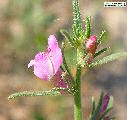 | |
| MaltaWildPlants.com by Stephen Mifsud |

|
| |
|
|
 |  |  |  |
| External Links: |
|
Himantoglossum robertianum (Giant Orchid) |
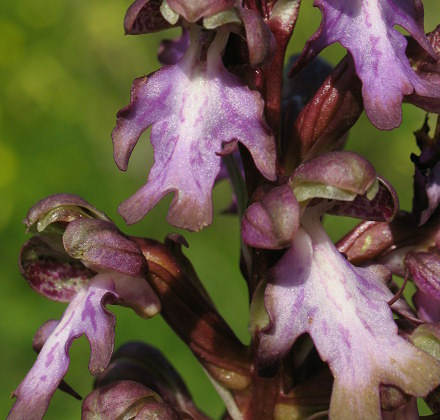
Himantoglossum robertianum (ORCHIDACEAE.)
Images for this profile are taken from the Maltese Islands after year 2000. |
|
| Nomenclature |
Species name: |
Himantoglossum robertianum (Loisel.) P.Delforge |
Author(s): |
R. J. Loiseleur, France, (1938 - ) ;
Pierre Delforge, Belgium, (1945 - )
|
Common names: |
Giant Orchid |
Maltese name: |
Orkida kbira |
Plant Family: |
|
Name Derivation: |
Himantoglossum = literally meaning a strap- or belt-shaped tongue and it alludes to the long thin appendages of the lip of many species of this genus, the least prominent however being in Himantoglossum robertianum. (Latin origin ); 2 = Named after the French botanist Jean-Baptiste Barla.
robertianum = Named after another French botanist - Gaspard Nicolas Robert (1776-1857). (Latin origin ); 2 = Named after another French botanist - Gaspard Nicolas Robert (Robert is the surname). |
Synonyms: |
Barlia robertiana |
Remarks: |
Not recorded in the past despite being a large and colourful orchid, perhaps got introduced naturally by wind dispersal of seed in the mid 20th century. Still rare on our islands, but it has been reported from some ten localities in the last 20 years.
|
|
| Morphology and structure |
PLANT STRUCTURE: |
Character | Growth Form | Branching | Surface |
Description | | | |
General
Picture |  | 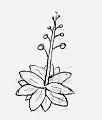 | 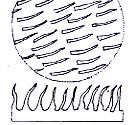 |
|
LEAVES: |
Character | Arrangement | Attachment | Venation |
Description | | | |
General
Picture | 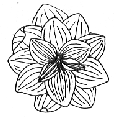 | 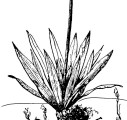 |  |
| |
Character | Leaf Shape | Leaf Margin | Remarks |
Description | | | |
General
Picture | 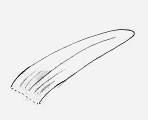 |  |  |
|
FLOWERS: |
Character | Colour | Basic Flower Type | No. of Petals | No. of Sepals |
Description | Purple, Pink and Maroon Labellum purple or pink with pale spots, other tepals have a maroon or purple-red colour. | | 3 2 small and inconspicuous and 1 complex and colourful (labellum). | 3 Identical, Purple to maroon, hood-shaped and located at the back part of the flower. |
General
Picture | |  |  |  |
| |
Character | Inflorescence | Description | Ovary | Stamens |
Description | | Flower consists of 3 identical, maroon to purple, hood-shaped, outer perianth segments (= sepals) and 3 inner perianth segments (= petals) of which 2 are small and pale green and the other, called labellum, is a modified lip-shaped petal. The labellum is large, very conspicuous, colourful and divided into 4 lobes. It has a maroon to brown margin which turns to purple and then to pink towards the centre. The central pale part is decorated with small purple patches. | | |
General
Picture |  |  |  | 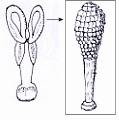 |
| |
Character | Scent | Average Flower Size | Pollen Colour | Other Notes |
Description | YES Faint Sweet Smell. | 30mm x 25mm x 18mm (Length x Breadth x Depth including sepals). The Labellum is 22mm long and 18mm wide. | Maroon | - |
|
SEEDS: |
Character | No. Per Fruit | Shape | Size | Colour |
Description | > 2,000 Despite the large amounts, propagation by seeds is not much viable for Orchids . | Powder form (very small to have a distinct shape ). | Extremely small (powder form). | Ash Gray |
General
Picture |  |  |  |  |
|
FRUIT AND OTHER BOTANICAL DATA: |
Character | Fruit Type | Colour of Fruit | Subterranean Parts | Other Notes |
Description | | Green to Maroon (turns light brown when ripe.). | | Germination and Growth The germination and growth of the plant is successful only with the presence of specific microrhizzial funghi in the soil. |
General
Picture |  |  | 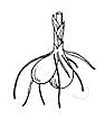 |  |
|
|
| Plant description and characters | |
Life Cycle: | Perennial. |
Growth Form: | GEOPHYTE (bearing underground bulbs, rhizomes, stolons, etc.) |
Habitat: | Garigue, open maquis, and open rocky locations |
Frequency: | Very Rare |
Localities in Malta: | Locations remain undisclosed to protect this rare and beautiful Orchid. |
Plant Height: | 25cm - 80cm. |
| Jan-Feb |
Protection in Malta: | Protected by law: Schedule VI of [S.L. 549.44] (strictly protected species) |
Red List 1989: | Threatened status for the Maltese Islands and has been listed in the Red Data Book (1st ed.) |
Poison: | |
This extremely rare orchid is easily distinguishable from the other Maltese and most European wild orchids by its large size and hence its name "Giant Orchid". This Orchid can reach up to 80cm in height.
The bright green leaves are also relatively large; the obtuse ovate to lorate blades can be 10cm wide to 30cm long. They show parallel venation and have a smooth margin which sometimes can have a sinusoidal (wavy) structure. The few-numbered leaves grow directly from the underground tubers as a basal rosette, with the younger ones becoming erect and wrap around the base of the flowering stalk.
The inflorescence is a rather large, cylindrical, dense spike of many flowers (more than 25). The mature spike measures about 15cm or more. Each flower has a labellum of about 2cm (largest amongst the Maltese Orchids).
Each flower has of a rather narrow and long, tapering bract which is longer than the perianth as it measures between 3 or 4cm. The bract is green with purple margins and tip. The Perianth is attached to the flowering stalk by its inferior ovary, usually covered by the bract and the perianth itself.
The perianth consists of 6 tepals or perianth segments; 3 external (=sepals) and 3 internal (=petals). The outer tepals are identical, arranged as an inverted T-shape, 10mm x 6mm in size and are found spreading out. They have a hood-shaped structure, that is curved inwards as concave. They are purple or have many intersecting purple patches with 3 longitudinal green veins. However, from their back, they generally look as maroon.
The inner tepals are arranged as a Y-shape of which the upper two are inconspicuous and arching over the stamenoid column forming a helmet, while the lower one is large, colourful, modified, lip-like structure (called labellum). The labellum has 3 lobes with the median one subdividing into 2 further branches. The undulated margin is maroon or dark brown, which turns to bright purple and then fades to pink or white towards the longitudinal axis. Along the paler parts there are numerous separate irregular purple patches. The flower bears a relatively small (5mm) rounded white spur.
The male reproductive organs consist of 2 pollinia each covered by a brownish pouch-like structure called theca. The pollinia have joined viscidia. The stigma is found as cavity below and behind the stamenoid column.
When the flower is fertilized by a suitable pollinator (eg. Bomblus spp.), the perianth parts shrivel and drop while the inferior ovary enlarges with the developing seeds forming an elongated, ovate fruit capsule which have bulging longitudinal ridges. The bract remains covering partially the ovary. When ripe, the fruit capsule opens up and releases the thousands of tiny and light seeds, which can be dispersed away by wind. Success of seed germination is very low, as in many Orchids.
|
|
| Information, uses and other details |
Nativity and distribution
This plant was first described in France and it is present in several European countries of Mediterranean and central Europe, but it is absent in the Middle East and the Adriatic region. [WWW-156] Another source shows the distribution of Barlia by means of a map (click here) which includes Portugal, France, Spain, Italy, Greece, Cyprus, Crete, Algeria, Marocco and Turkey amongst others.
Nomenclature
Barlia is derived from the surname of French botanist - Jean-Baptiste Barla who was not the one who described the Orchid. His friend Parlatore, first described the plant in 1858 and dedicated and named it to Barla. However the authority for this species reads " (Loisel) W. Greuter" both born in the early-mid 20th century, indicating that there has been systemic changes in the nomenclature of this taxon. Robertiana is similarly attributed to another French botanist - Gaspard Nicolas Robert - (Robert is his surname). [WWW-156]
The species name Barlia robertiana has been used for many years, until recently it is suggested to be moved to a new taxon - that of Himantoglossum robertiana. Other scientific names used in Eastern Europe, like Comperia comperiana are also considered to be moved into the Himantoglossum genus. [WWW-156]
In Germany, the orchid is called "Mastorchis" which means "Scary Orchid", probably due its overall dull appearance, but on a closer look, it reveals that on the contrary, it is a quite beautiful species. [WWW-156]
General Notes
+ The Giant Orchid is the largest wild orchid in Europe.
+ There is no close relative to the plant except one - Himantoglossum metlesicsianum This species is only scarcely found on the Canary islands and regarded as extinct in mainland Europe and the Mediterranean.
+ Since the plant has no close relatives, hybrids are seldom found.
+ In France it was protected for many years, and as a result, now the plant has become quite common. It is found to increase in most Mediterranean countries too.
+ In europe, the plant is usually found individually on garigues (especially at the coastline), maquis, light forests and street ditches. Since it can tolerate fertilizers, it grows also in olive groves and fields.
+ It is reported that it grows best below altitudes of 700m and do not like acid soils.
+ Seldom touched by animals.
This list of information above was obtained from reference [WWW-156]
+ One source mentions that the flower is pollinated by Bomblus species, namely B. terrestris [WWW-157]
+ Although not an endemic, the plant is protected in Malta because of its scarcity. [376]
Reward supplementation experiments with Barlia robertiana.
The Orchidaceae characteristically contain a very large number of species that attract pollinators but do not offer them any form of reward in return for visitation. Such a strategy is highly unusual in the plant kingdom. We conducted experiments in order to manipulate the reward strategy of the rewardless bumble-bee-pollinated orchid Barlia robertiana by adding sucrose solution to inflorescences. We found that supplementation decreased the probability of a pollinator removing pollinia by approximately ten times. Despite pollinators visiting many more flowers per inflorescence on supplemented plants, eight times fewer pollinia were removed from supplemented inflorescences during each visit. Pollinia deposition patterns were not significantly affected by supplementation and no geitonogamous deposition was recorded. In populations where inflorescences were supplemented for 20 days, pollinia removal was reduced by over half for supplemented inflorescences, whereas fruit set was unmodified by supplementation. We conclude that rewardlessness would increase total seed paternity, but not change either total seed maternity or the probability that offspring were outcrossed in this species. To the authors' knowledge this is the first time that there has been an unequivocal experimental demonstration of an evolutionary advantage for rewardlessness in the Orchidaceae. [375]
Personal Observations
Natural conservation
Thanks to Maltawildplants.com, its forum and its forum members a network has been created in order to make it possible that the location of this Orchid will be handed to the Plant Biotechnology Centre of Lija. In consequence, the aim of this centre is to propagate in vitro large numbers of this Orchid and hopefully they could be restored back into nature and the Maltese environment. This is one of the most beautiful orchids in Europe since of its large inflorescence and flowers and it would be a righteous that Malta also has an abundance of this Orchid.
|
|
| Links & Further literature
(0 papers) |

Google Web |

Google Images |

Google Scholar |

Research Gate |

Wikipedia |

JSTOR |

GBIF |

Med Checklist |

Cat. of Life |

EoL |

IPNI |

World Flora Online |

Plants of the World Online |

Vienna Virt. Herb. |

RBGE Herbarium |

KEW Herbarium |

MNHN |

Arkive |

IUCN |

CABI |
Kindly Email if there are papers and publications about local
studies or information about this species to be included in the list above.
|
| Photo Gallery (27 Images) |  |
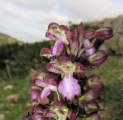 |
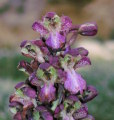 |
 |
IMAGE: HIMRB-01 Photo of the flowering spike and close up of one of the large flowers. Since of its rarity, only this plant is possible to photograph, and as it can be seen, it is not in a good shape - margins of labellum burnt out probably by strong wind. |
IMAGE: HIMRB-02 Close up photo of the flower which its lip measures about 2cm long. Despite the margins are destroyed, the flower usually have 4 lobes, or as others describe it, it has 3 lobes with the central one split into two long arms. |
IMAGE: HIMRB-03 Photo of another flower of the inflorescence. The upper and outer perianth segments (=sepals) are rounded, concave and have several purple patches that can intersect in each other. |
IMAGE: HIMRB-04 Photo of flowers along the long flowering spike. This particular spike produced about 30 flowers. |
 |
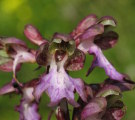 |
 |
 |
IMAGE: HIMRB-05 Photo of few flowers of the Giant Orchid. The flowers are also the largest amongst the Orchids found in Malta. The length of the lip is about 2cm. |
IMAGE: HIMRB-06 Close up photo of the flower showing the detail of the mouth and the lip. |
IMAGE: HIMRB-07 Photo of some flowers along the spike. Often many flowers are open in a single spike mostly due to the long life of the flower. |
IMAGE: HIMRB-08 Close up photo of a flower showing the detail of the labellum and its colours. |
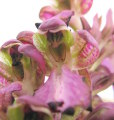 |
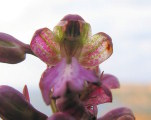 |
 |
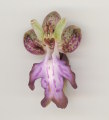 |
IMAGE: HIMRB-09 Close up photo of the mouth of the flower. At the roof there is the male organs which are two pollinia wit ha common viscidium. The female part lies at the back of the flower in a beak-like structure called rostellum. If the pollinia are transferred inside this beak by a pollinator (eg. Bomblus spp.), fertilisation takes place. |
IMAGE: HIMRB-10 Close up photo of the flower showing in focus the outer tepals. They are curved inwards like a small hood, have 3 longitudinal green veins and many purple patches. |
IMAGE: HIMRB-11 Photo of the back side of the flower reveals that it is simply maroon or purple-brown in colour. |
IMAGE: HIMRB-12 Scanned image of a flower. It has 3 lobes, with the median one further divided into 2 arms. Note how the brown colour at the margins changes to purple, pink and white to the centre. |
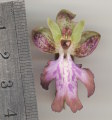 |
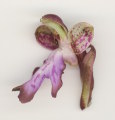 |
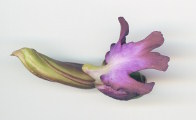 |
 |
IMAGE: HIMRB-13 Scanned image of a typical flower also showing the millimetre scale to indicate the measurements of the flower parts. |
IMAGE: HIMRB-14 Scanned image of the side of the flower. Note that the margins of the lip are undulated (wavy). |
IMAGE: HIMRB-15 Scanned image of the underside of the lip, showing also the relatively small white spur. |
IMAGE: HIMRB-16 Annotated and scanned image of the mouth of the flower showing the reproductive organs. This particular flower has been pollinated since pollen grains can be seen in the stigmatic cavity. The pollinia have also been carried away leaving and 'empty' thecum. |
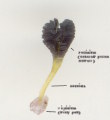 |
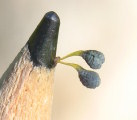 |
 |
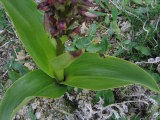 |
IMAGE: HIMRB-17 Scanned and annotated image of the pair of pollinia. They have a common viscidium. |
IMAGE: HIMRB-18 Photo of the pollinia. They have a greyish-dull blue colour. |
IMAGE: HIMRB-19 Annotated photo of an old flower showing its bract, ovary and dried flower remnants. The bract is much longer than the flower and tapers to a pointed tip. Usually it is green with a purple margin and cover most of the ovary. |
IMAGE: HIMRB-20 Photo of the large leaves of this orchid. They can grow up to 10cm in width by 30cm in length. The plant forms few leaves arranged as a basal rosette with the younger ones becoming erect and sheathing the flowering stalk. |
 |
 |
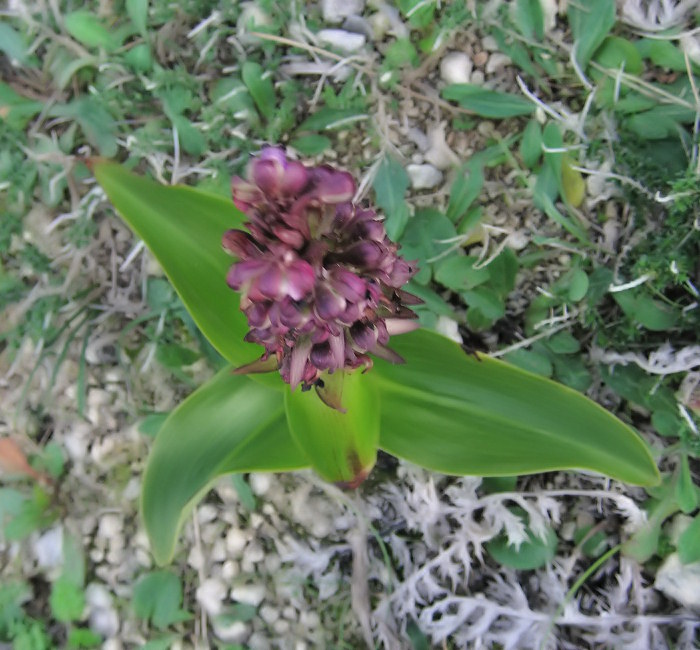 |
 |
IMAGE: HIMRB-21 Photo of one of the large leaves of this Orchid. This leaf measured nearly 24cm in length. |
IMAGE: HIMRB-22 Photo of basal part of plant showing its leaves. They are arranged as a basal rosette with the younger ones becoming erect and sheathing the scape. |
IMAGE: HIMRB-23 Photo showing top view of the plant found at the North-West region of Malta. |
IMAGE: HIMRB-24 Photo of this large orchid, having both large leaves and tall inflorescences (8cm -25cm). The inflorescence is a dense, cylindrical spike. |
 |
 |
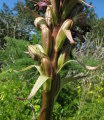 |
| IMAGE: HIMRB-25 Photo of another plant in Malta (Central/ North East region). |
IMAGE: HIMRB-26 Photo of the flowering spike and its numerous flowers. |
IMAGE: HIMRB-27 Photo of fruit capsules which are ovate-cylindrical and have longitudinal bulging ridges. |
IMAGE: HIMRB-28 |
|
| | |

